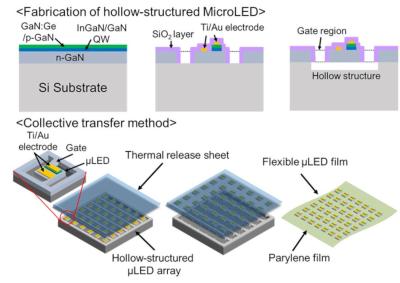Researchers from Japan's Toyohashi University of Technology and the Okinawa Institute of Science and Technology Graduate University have developed a flexible, multipoint microLED array film that can be flexibly attached to cover the brain and can illuminate specific brain regions.

The manipulation of neural activity by light (enabled by optogenetics), requires a thin, flexible and lightweight lighting source that is not toxic to living tissue. The new microLED film is highly suitable for this task, and the researchers hope that such devices will create a new area of neuroscience research aimed at comprehensively understanding the brain information that underpins how neural activity, behaviors, and disorders are linked.
The whole film is less than 100 um in size, and a couple of micrometers in thickness. The LEDs are arranged on multpliepoints. To create this film, the researchers adopted an anisotropic wet etching method using potassium hydroxide to selectively remove the bottom LED layer, which led to the formation of a hollow structure of microLEDs that are arranged at high density. As the hollow structure separates the LED layer from the substrate, only the LED layer can be removed at one time using a thermal release sheet with no damage to either microLEDs or biocompatible Parylene films.
Source:
Posted: Mar 20,2022 by Ron Mertens

